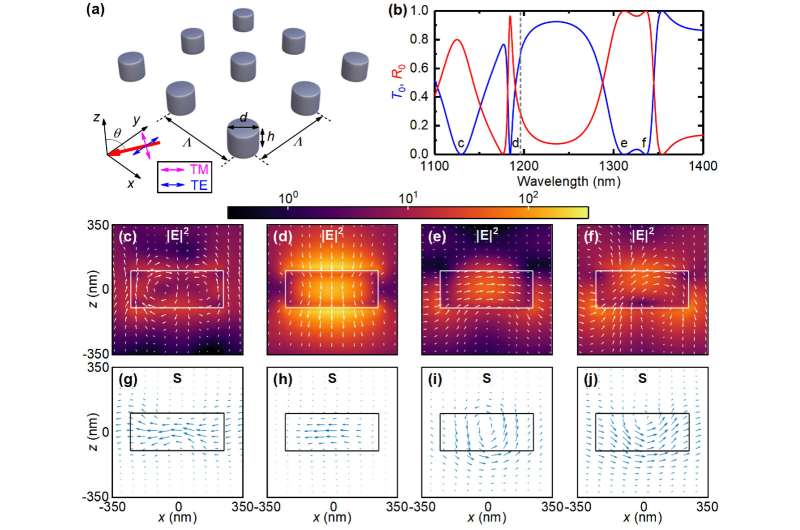(a) Schematics of the two-dimensional periodic silicon disks under oblique incidence with TM or TE polarization. The disks have diameter ?d, height ℎh, and lattice periods ΛΛ in ?x and ?y directions. (b) Simulated reflectance and transmittance spectra of the silicon disk array under oblique incidence of ?=15∘ with TM polarization. The vertical dashed line indicates the (−1,0) RA wavelength. (c)–(f) Near-field electric field distributions |?2(color for intensity and arrows for directions) and (g)–(j) Poynting vector maps at the four resonance wavelengths indicated in (b): ?=1130λ=1130 nm, 1184.41184.4 nm, 1312.21312.2 nm and 1336.21336.2 nm from left to right. In (c)–(j) the silicon disk is outlined by the rectangle. Credit: Optics Express (2022). DOI: 10.1364/OE.471356
High-index dielectric nanostructures supporting electric and magnetic resonances have emerged as new building blocks in nanophotonics for novel functionalities.
By periodically arranging these nanostructures, the coherent interference between the localized Mie resonances of single nanostructures and the in-plane diffracted light can result in the so-called Mie surface lattice resonances (SLRs).
Researchers from the Shenzhen Institute of Advanced Technology (SIAT) of the Chinese Academy of Sciences investigated the periodic silicon nanodisks under oblique incidence with transverse magnetic polarization, and discovered out-of-plane Mie electric dipole surface lattice resonance (ED-SLR) for the first time.
The study was published in Optics Express on Sept. 7.
The team discovered that the out-of-plane Mie ED-SLR could be excited together with the in-plane electric dipole SLR (ED-SLR), magnetic dipole SLR (MD-SLR) and magnetic quadrupole SLR (MQ-SLR) in periodic silicon nanodisks under oblique incidence. They found that the out-of-plane Mie ED-SLR could have four times larger quality factors than the in-plane one under the same condition.
Li's team noticed that, unlike the out-of-plane plasmonic ED-SLR, which is a subradiant or dark mode, the out-of-plane Mie ED-SLR can be treated as a bright mode, and has distinct near-field optical distributions and dispersion relationship.
"This is because the dipole field for Mie ED-SLR is induced by displacement currents, and the plasmonic ED-SLRs are induced by free electron gases," said Dr. Li Guangyuan, corresponding author of the study.
The researchers also found that the out-of-plane Mie ED-SLR can define a symmetry-protected bound state in the continuum at normal incidence. This is because the out-of-plane Mie ED-SLR is not allowed to emit at normal incidence. For small incidence angles, the quality factor can even reach as high as 104.
"This work provides a new approach for achieving ultrahigh quality factors of Mie SLRs in dielectric metasurfaces," said Dr. Li "Additionally, the coexistence of multipole SLRs open new prospects for manipulating light-matter interactions."
More information: Xueqian Zhao et al, High-Q out-of-plane Mie electric dipole surface lattice resonances in silicon metasurfaces, Optics Express (2022). DOI: 10.1364/OE.471356
Journal information: Optics Express
Provided by Chinese Academy of Sciences























